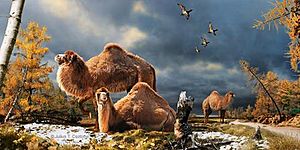High Arctic camel
Imagine a camel living in the Arctic! The High Arctic camel was a type of ancient camel that lived millions of years ago during the Pliocene Age. It's related to the first camels that modern camels came from, and also to the huge Yukon giant camel that lived during the Ice Age.
Scientists found fossils of this camel in 2006 near Strathcona Fiord on Ellesmere Island in Nunavut, Canada. The High Arctic camel lived at least 3.4 million years ago. Back then, the Arctic was much warmer, and it was covered in forests, not ice!
Finding an Ancient Camel
Scientists found parts of the High Arctic camel over several years, from 2006 to 2010. They were working in the Strathcona Fiord area of Ellesmere Island, which is way up north in the Canadian Arctic.
They collected about 30 small pieces of bone from a place called the Fyles Leaf Bed site. These pieces fit together to form part of a right shin bone (called a tibia). The shape of the bone showed it came from a hoofed mammal, like a cow, deer, or camel. The size of the bone suggested it was from a camel, because camels were the biggest hoofed mammals in North America at that time. This was the first time anyone found proof of camels living in the High Arctic!
Camel Clues from Fossils
To be sure the bones were from a camel, scientists used a special method called "collagen fingerprinting." Collagen is a type of protein found in bones. They compared the ancient collagen from the fossil to collagen from 37 types of modern mammals. They also compared it to the giant Yukon camel from the Ice Age.
The results showed that the High Arctic camel was most similar to the one-humped Dromedary camel and the Yukon giant camel. This "fingerprinting" helped them confirm it was indeed an ancient camel.
When and Where the Camel Lived
Scientists used a special dating method to figure out how old the camel fossil was. They found that the fossil is at least 3.4 million years old. This means the camel lived during a time when the Earth was warmer than it is today.
Studies of the ancient environment show that the High Arctic camel lived in a forest. This forest was like the "boreal" forests we see in colder parts of the world today, with lots of larch trees. At that time, global temperatures were about 2 to 3 degrees Celsius warmer than now. In the Strathcona Fiord area, it was even warmer, perhaps 14 to 22 degrees Celsius warmer than today. Even so, winters would have still been cold and snowy!


